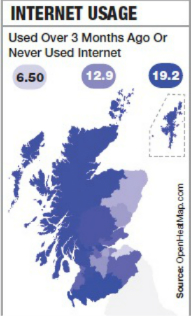
It is Scotland's great digital faultline - and it divides the country neatly from from east to west.
Fully one in five people in Dumfries and Galloway and nearly as many in both East Dunbartonshire have not used the internet in the last three months.
But that figure - which includes both those who have never surfed the web and those who have stopped doing so - plunges to just 6.5 per cent in East Lothian and Midlothian and 9.6 per cent in Aberdeenshire.
The east, it seems, is as rich online as off.
The numbers, which come from Britain's Office of National Statistics, seem to underline that the haves and have-nots of the digital world tend to mirror those in the real, analogue one.
Policy makers increasingly see digital exclusion as a key indicator of well-being, up with housing or access to quality healthcare.
They fear the poor and the elderly, or elements of the poor and the elderly, are missing out on internet access most of us take for granted.

Chris Yiu, director of digital participation at the Scottish Council for Voluntary Organisations, explained: "Lots of people who don't use the internet say it's because they don't see what's in it for them.
"We reach out to people, and help them see the uses.
"People who haven't got the skills tend to be older, often retired, living with a disability or long term illness, or from the C2DE social grades."
The Herald has mapped digital exclusion by local authority - and found a fairly clear correlation with median income.
Dumfries and Galloway and East Dunbartonshire - with their many pensioners - have median incomes averaging at under £10 an hour.
They also have the highest levels of internet lapsers or non-users.
Median hourly income at the 10 councils with the highest proportion of their populations online is fully £1 higher than the figure for the 10 councils with the lowest internet access.
The division isn't just from east to west. Dumfries and Galloway lags behind neighbouring South Ayrshire in online participation by as much as six percentage point. Dumfries and Galloway's median income is £1.68 an hour lower than South Ayrshire's.
Aberdeenshire - which, like Dumfries and Galloway, and the Highlands - has rough, rural terrain - way outperforms the south-west.
Again, its median income is much higher.
The Scottish Government and Dumfries and Galloway Council both boast of efforts to boost broadband access.
However, booming purchases of smartphones could mean that access to broadband is no longer as important a factor in understanding the figures as it was in the past, said Mr Yiu.
He added: "Anecdotally, when I'm out and about meeting people using the internet for the first time, they're often doing it on smartphones. They're definitely improving accessibility."
The cost of the internet, those concerned with digital exclusion argue, could be every bit as important as its speed.


Why are you making commenting on The Herald only available to subscribers?
It should have been a safe space for informed debate, somewhere for readers to discuss issues around the biggest stories of the day, but all too often the below the line comments on most websites have become bogged down by off-topic discussions and abuse.
heraldscotland.com is tackling this problem by allowing only subscribers to comment.
We are doing this to improve the experience for our loyal readers and we believe it will reduce the ability of trolls and troublemakers, who occasionally find their way onto our site, to abuse our journalists and readers. We also hope it will help the comments section fulfil its promise as a part of Scotland's conversation with itself.
We are lucky at The Herald. We are read by an informed, educated readership who can add their knowledge and insights to our stories.
That is invaluable.
We are making the subscriber-only change to support our valued readers, who tell us they don't want the site cluttered up with irrelevant comments, untruths and abuse.
In the past, the journalist’s job was to collect and distribute information to the audience. Technology means that readers can shape a discussion. We look forward to hearing from you on heraldscotland.com
Comments & Moderation
Readers’ comments: You are personally liable for the content of any comments you upload to this website, so please act responsibly. We do not pre-moderate or monitor readers’ comments appearing on our websites, but we do post-moderate in response to complaints we receive or otherwise when a potential problem comes to our attention. You can make a complaint by using the ‘report this post’ link . We may then apply our discretion under the user terms to amend or delete comments.
Post moderation is undertaken full-time 9am-6pm on weekdays, and on a part-time basis outwith those hours.
Read the rules hereComments are closed on this article